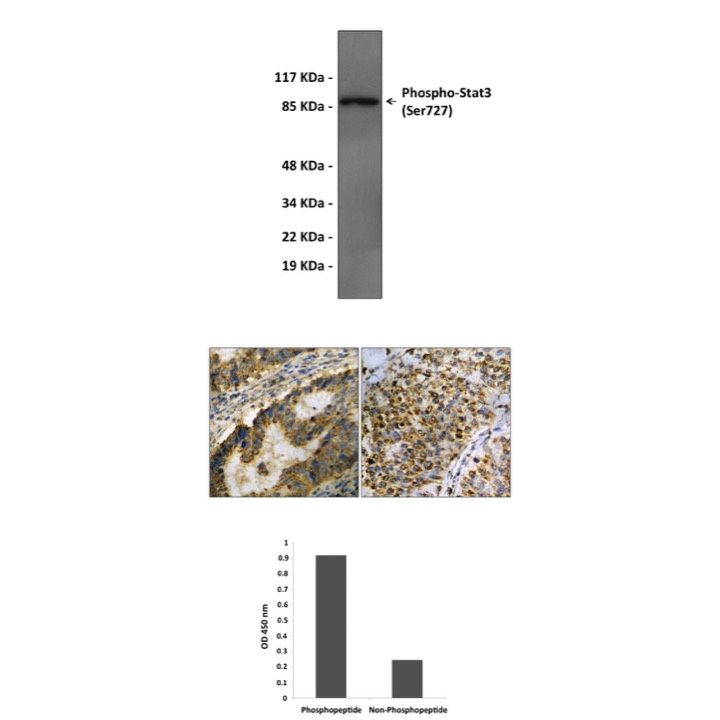Product Sheet CG1572
Description
BACKGROUND Signal transducers and activators of transcription (STATs) comprise a unique family of transcription factors that transmit the interactions of cytokines, hormones, and growth factors with their cell surface receptors into transcriptional programs. The mechanism of STAT activation has been well-established and comprises tyrosine phosphorylation, dimerization, nuclear translocation, binding to specific DNA response elements, recruitment of co-activators or co-repressors, and transcriptional induction or repression of target genes.1
STAT3, a member of STAT family, has been known as a mediator for gene expression induced by many important cytokines and growth factors.2 It plays diversified roles from cell growth, differentiation, apoptosis, oncogenesis, and stem cell renewal regulations. Stat3 is constitutively activated in many human cancers where it functions as a critical mediator of oncogenic signaling.3 Thus Stat3 is also a target for cancer therapy.
Activation of STAT3 is triggered by phosphorylation of Tyr705 in its Src homology 2 domain, resulting in dimerization, nuclear translocation, and transcriptional activation of target genes. Additionally, phosphorylation of STAT3 on Ser727, situated in the C-terminal transactivation domain, results in enhanced transcriptional activation and DNA binding capacity. Various kinases have been shown to phosphorylate STAT3 on Ser727, depending on the cytokines and growth factors involved and the cellular context.4
STAT3, a member of STAT family, has been known as a mediator for gene expression induced by many important cytokines and growth factors.2 It plays diversified roles from cell growth, differentiation, apoptosis, oncogenesis, and stem cell renewal regulations. Stat3 is constitutively activated in many human cancers where it functions as a critical mediator of oncogenic signaling.3 Thus Stat3 is also a target for cancer therapy.
Activation of STAT3 is triggered by phosphorylation of Tyr705 in its Src homology 2 domain, resulting in dimerization, nuclear translocation, and transcriptional activation of target genes. Additionally, phosphorylation of STAT3 on Ser727, situated in the C-terminal transactivation domain, results in enhanced transcriptional activation and DNA binding capacity. Various kinases have been shown to phosphorylate STAT3 on Ser727, depending on the cytokines and growth factors involved and the cellular context.4
REFERENCES
1. Desrivieres S et al.: J Mammary Gland Biol Neoplasia. 11:75 (2006).
2. Fu XY: Cell Res. 16:214 (2006).
3. Jing N & Tweardy DJ: Anticancer Drugs. 16:601 (2005).
4. Plaza-Menacho I et al.: J. Biol. Chem. 282:6415-24 (2007).
2. Fu XY: Cell Res. 16:214 (2006).
3. Jing N & Tweardy DJ: Anticancer Drugs. 16:601 (2005).
4. Plaza-Menacho I et al.: J. Biol. Chem. 282:6415-24 (2007).
Products are for research use only. They are not intended for human, animal, or diagnostic applications.
Details
Cat.No.: | CG1572 |
Antigen: | Range AA711 to 743. |
Isotype: | Rabbit IgG |
Species & predicted species cross- reactivity ( ): | Human, Rat, Mouse |
Applications & Suggested starting dilutions:* | WB 1:500-1:1000 IP 1:200 IHC 1:50-1:100 ICC n/d FACS n/d ELISA 1:10000 |
Predicted Molecular Weight of protein: | 88 kDa |
Specificity/Sensitivity: | Detects endogenous phospho-Stat3 (Ser727) without cross-reactivity with other family members. |
Storage: | Store at -20°C, 4°C for frequent use. Avoid repeated freeze-thaw cycles. |
*Optimal working dilutions must be determined by end user.
Products
| Product | Size | CAT.# | Price | Quantity |
|---|---|---|---|---|
| Rabbit Stat3, Phospho-Ser727 Antibody: Rabbit Stat3, Phospho-Ser727 Antibody | Size: 100 ul | CAT.#: CG1572 | Price: $384.00 |

